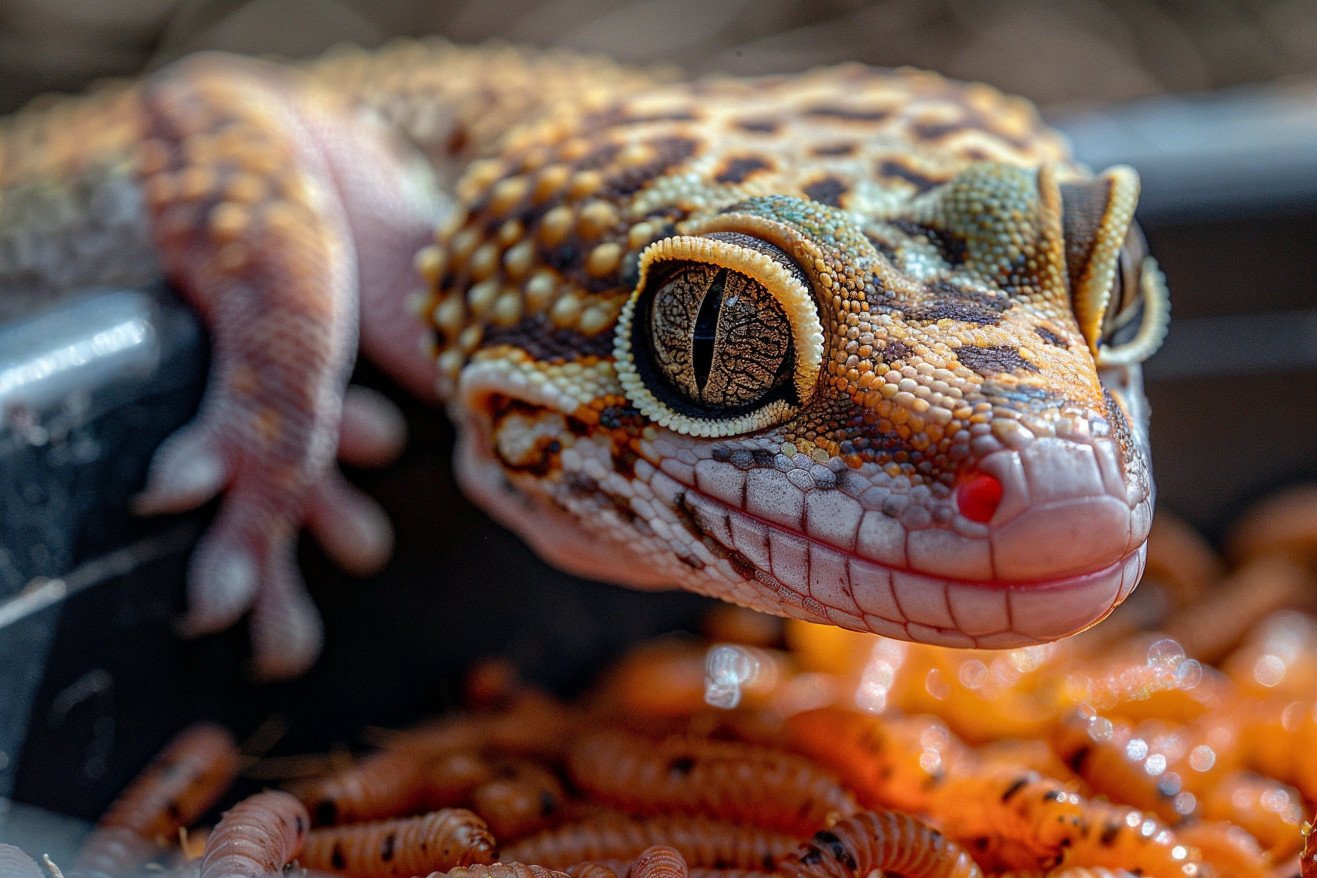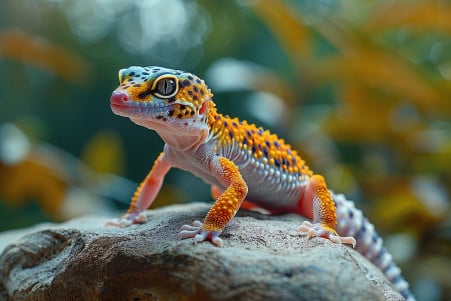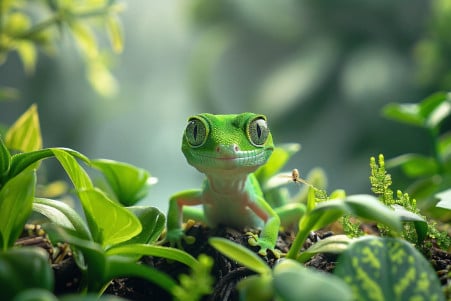Leopard Gecko Diet: Feeding the Right Amount of Mealworms
19 April 2024 • Updated 17 April 2024

If you're a leopard gecko owner, you know how important it is to make sure you're feeding your pet the right amount of mealworms. Most herpetologists and experienced reptile owners agree that adult leopard geckos should be fed between 10-12 mealworms every 1-2 days, although the exact amount can depend on the gecko's age, size, and activity level. For juvenile leopard geckos, you should feed them between 5-7 mealworms every other day and adjust the amount as they grow. In addition, make sure to dust the mealworms with a calcium and vitamin D3 supplement 2-3 times a week.
To ensure that you have all the information you need to feed your leopard gecko the right amount of mealworms, we're going to take an in-depth look at the research conducted by herpetologists and experienced reptile owners. This research covers everything from how often you should feed your leopard gecko to the right portion sizes and supplementation amounts based on factors like age, weight, and whether or not your leopard gecko is breeding. By reviewing this research, you'll be able to create a diet plan that meets your leopard gecko's unique dietary needs.
How many mealworms should you feed a leopard gecko?
Varying the Leopard Gecko Diet
Even though mealworms are the go-to feeder insect for many leopard gecko owners, it’s important to remember that these reptiles need a varied diet to get all the nutrients they require. In fact, according to Leopard Gecko Care, experienced keepers will feed a variety such as "dubia roaches, phoenix worms, silkworms, locusts, and the occasional waxworm" in addition to mealworms because each type of insect has a different protein, fat, fiber, and calcium-to-phosphorus ratio.
Dragon's Diet suggests feeding a variety of dubia roaches (arguably the most nutritious feeder), crickets, locusts, hornworms (a great source of water), and treats like superworms, waxworms, butterworms and silkworms. Meanwhile, OnlineGeckos.com explains that while crickets and mealworms are good staples, most feeder insects have an unfavorable calcium-to-phosphorus ratio when fed in isolation.
This means that it’s important to make sure that your leopard gecko’s diet is varied. In addition to nutritional value, ReptiFiles points out that other factors like the ease of keeping the insect, availability, and your gecko's willingness to eat it can also play a role in deciding which feeder to feed. However, by rotating between a few different types of insects, including those that are high in nutrients like dubia roaches, and supplementing with calcium/D3, you can make sure that your leopard gecko is getting everything they need.
How Often Should You Feed Your Leopard Gecko?
Leopard geckos have different feeding frequencies depending on their age and size. According to Zen Habitats, juveniles should be fed daily, young adults every 2-3 days, and adults with thicker tails every 5 days. In general, you should aim to feed 2 insects per inch of the gecko's length, or enough to fill it up in 15 minutes.
You should never leave feeder insects in the enclosure, as they can harm your gecko. In fact, Leopard Gecko Care notes that leaving insects in the enclosure for the entire day can lead to life-threatening injuries. On the other hand, it's normal for leopard geckos to go off their food for weeks or even months at a time, as long as they don't lose weight.
How to Avoid Overfeeding and Monitor Leopard Gecko Health
Overfeeding is especially common in new leopard gecko owners and can result in serious health concerns. According to Reptiles Universe, symptoms of overfeeding include regurgitation, lethargy, and an unusually thick or fat tail. Reptile Craze also notes that obesity caused by overfeeding can lead to other issues such as hepatic lipidosis, a potentially fatal fatty liver disease.
It is important to monitor your gecko's weight and body condition every 2 weeks to catch any potential problems. MedVet also notes that some common health issues associated with a poor diet include hypovitaminosis A, which can cause eye and shedding problems, and nutritional secondary hyperparathyroidism, which can cause skeletal deformities. Intestinal impactions are also a concern, especially if you are using substrates that are not safe.
You should also avoid making sudden changes to your gecko's diet, as this can make them sick. As Reptile Craze recommends, it is best to talk to a vet before making any major changes to your leopard gecko's diet.
Setting Up the Perfect Leopard Gecko Habitat
Leopard geckos need a habitat that matches their natural desert and grassland home. According to Terrarium Quest, this means a minimum 20-gallon tank with a heat lamp or mat to help regulate the temperature.
The temperature should be between 70-90°F, with a basking temperature of 87-90°F and a cool side of 74-80°F, according to Leopard Gecko Care. Humidity should be between 20-40%, with a humidity level of 70-80% in the moist hide.
To make the habitat work for your leopard gecko, the tank should also include hides on the warm and cool sides, a water dish, and a calcium dish, according to The Spruce Pets. By including these different aspects, you can make sure that your leopard gecko's home is a happy and healthy one.
Conclusion: How to Create a Balanced Diet
While mealworms are a good staple feeder insect for leopard geckos, they should not make up the entirety of the gecko's diet. According to PetHelpful, mealworms are low in nutritional value and don't contain the vitamins that leopard geckos need to stay healthy. This is why it's important to "gutload" the mealworms by feeding them nutrient-rich foods before giving them to your gecko.
In addition, Leopard Gecko Care suggests dusting the mealworms with calcium powder at every feeding, and calcium with vitamin D3 powder about twice a week. This is important to ensure proper calcium metabolism and avoid deficiencies.
The amount of food you give your leopard gecko will also depend on its age and size. Zen Habitats recommends feeding juveniles daily, young adults every 2-3 days, and adults with a plump tail every 5 days. In general, you should feed your leopard gecko 2 insects that are appropriately sized for every inch of the gecko's length, or as much as it can eat in 15 minutes.
It's also important to monitor the gecko's weight, body condition, and overall health to ensure that they aren't being overfed and that they're getting the nutrition they need. By following the recommendations in this article, leopard gecko owners can make sure their pets get the balanced, nutritious diet they need to grow and thrive.


